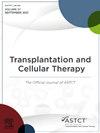Pediatric Transplant and Cellular Therapy Consortium RESILIENT Conference on Pediatric Chronic Graft-versus-Host Disease Survivorship after Hematopoietic Cell Transplantation: Part II. Organ Dysfunction and Immune Reconstitution Considerations for Children with Chronic Graft-versus-Host Disease after Hematopoietic Cell Transplantation
IF 3.6
3区 医学
Q2 HEMATOLOGY
引用次数: 0
Abstract
While highly morbid forms of chronic graft versus host disease (cGVHD) and severe late effects of allogeneic hematopoietic cell transplantation (HCT) can impact children and adults alike, unique considerations arise in pediatric cases regarding diagnosis, monitoring, treatment, and likelihood of resolution. As children can present with atypical features of cGVHD and with more significant disease due to inability to communicate symptoms, they may be at increased risk for highly morbid forms of cGVHD and incur greater subsequent late effects, which may be more pronounced in those with underlying chromosomal breakage syndromes, with higher prevalence in pediatric HCT recipients. The long-term effects of cGVHD and its therapies include impaired immune reconstitution, leading to increased risks of infection and secondary malignant neoplasms. However, children also have the greatest potential for full immune reconstitution, due to thymus recovery that could impact the timing of vaccination with respect to tolerance and restoration of optimal immunity. Developing strategies to mitigate the late effects incurred with, and as a result of, cGVHD is of critical importance. The working group recommends surveillance strategies for late effects in patients with cGVHD, increased utilization of emerging diagnostic tools, integration of monitoring for cGVHD treatment response, and development of new treatments and specifies aims of future research endeavors.
儿童移植和细胞治疗联盟弹性会议:儿童慢性移植物抗宿主病造血细胞移植后存活:第二部分。造血细胞移植后慢性GVHD患儿器官功能障碍和免疫重建的考虑。
虽然高病态形式的慢性移植物抗宿主病(cGVHD)和同种异体造血细胞移植(HCT)的严重晚期效应可能影响儿童和成人,但儿科病例在诊断、监测、治疗和解决可能性方面存在独特的考虑。由于儿童可能表现出cGVHD的非典型特征,并且由于无法交流症状而出现更严重的疾病,因此他们可能具有更高的cGVHD高发病形式的风险,并产生更大的后续晚期效应,这在具有潜在染色体断裂综合征的患者中可能更为明显,在儿童HCT受体中患病率更高。cGVHD及其治疗的长期影响包括免疫重建受损,导致感染和继发性恶性肿瘤的风险增加。然而,儿童完全免疫重建的潜力也最大,因为胸腺的恢复可能会影响免疫接种的时间,从而影响耐受性和最佳免疫力的恢复。制定策略以减轻cGVHD引起的后期影响至关重要。工作组建议对cGVHD患者晚期效应的监测策略,增加对新兴诊断工具的利用,对cGVHD治疗反应的综合监测,开发新的治疗方法,并为未来的研究工作提供目标。
本文章由计算机程序翻译,如有差异,请以英文原文为准。
求助全文
约1分钟内获得全文
求助全文
来源期刊

Transplantation and Cellular Therapy
Medicine-Hematology
CiteScore
7.00
自引率
15.60%
发文量
1061
审稿时长
51 days
 求助内容:
求助内容: 应助结果提醒方式:
应助结果提醒方式:


